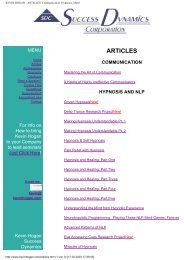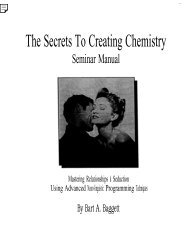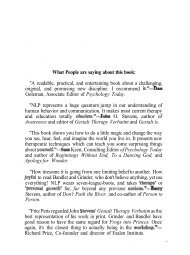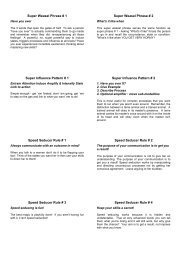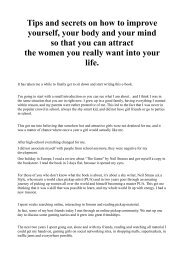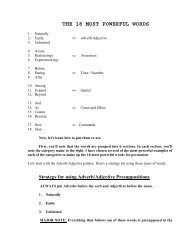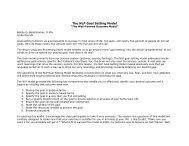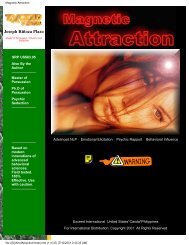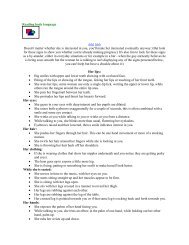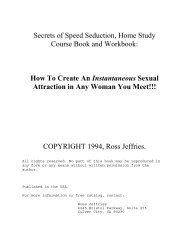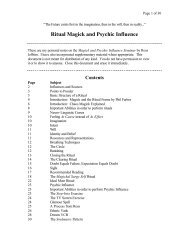A Pragmatic Guide To Communication & Change.pdf - NLP Info Centre
A Pragmatic Guide To Communication & Change.pdf - NLP Info Centre
A Pragmatic Guide To Communication & Change.pdf - NLP Info Centre
- No tags were found...
You also want an ePaper? Increase the reach of your titles
YUMPU automatically turns print PDFs into web optimized ePapers that Google loves.
the situation now."<br />
Susan<br />
Thomas<br />
Mark<br />
39<br />
I was noticing how, as the sun went down, everyone's voice got quieter, almost as if the<br />
36<br />
The third sentence in the numbered examples elicits experiences associated with the<br />
auditory system, and the fourth the olfactory-gustatory system. Though taste and smell are<br />
two distinct sensory mechanisms, they are grouped together for simplicity. Generally,<br />
unless you are a gourmet. chef or wine connoisseur, your model of the world probably<br />
does not contain as many distinctions in the olfactory representational system as in the<br />
other systems. In fact, the visual and kinesthetic appear to be two of the most often used<br />
systems in Western cultures.<br />
The last of the numbered sentences is unique because none of the words presuppose any<br />
of the sensory-based systems. This is an example of purely digital information. In such :i<br />
case, it is entirely up to the reader to "understand," using whatever system is best for him.<br />
This process will be<br />
informed as to body position, vibrations, and deep pain and pressure; and visceral sensations<br />
of pain and fullness from internal organs.<br />
In our language, however, we have identified another kind of "feelings," those we call<br />
emotions. When someone says, "I was hurt," he may be talking about pressure or pain on<br />
his skin, or he may be talking about some "internal state" called an emotion.<br />
Actually, the two meanings are very similar. <strong>To</strong> be "hurt" emotionally is a composite of<br />
several somatic sensations. For example, there may be a tightening around the eyes and<br />
face, changes in posture, stresses on deep muscle tissue, tendons, and joints, and often<br />
accompanying input from the viscera in the form of tightening or contractions. This<br />
sensory input is combined with other thought processes and is then labeled as emotional<br />
"hurt." Because of this close link with somatic sensations, it is useful to consider that<br />
those feelings we call emotions are actually derived feelings, or, in the formal notation:<br />
Kd.<br />
explored in great detail in this chapter. Olfactory-Gustatory Distinctions<br />
Language is used to communicate various aspects of our experience of the world to each<br />
other. By creating internal, sensory-based experiences in response to the words we read or<br />
hear, we are each able to understand what is being said. However, this synthetic<br />
experience can also operate in ways which prevent us from experiencing fully what the<br />
speaker or writer intends to communicate. Because our understanding is internally<br />
generated, it is affected by the universal human modeling processes of generalization,<br />
deletion, and distortion. Because we each have unique models of the world, the following<br />
axiom must be considered important to the study of connnunication:<br />
The meaning of any communication is defined by the response it elicits.<br />
Predicate Preference<br />
When listening to a person talk, sometimes a pattern becomes evident, a pattern of<br />
predicate preference. These<br />
37<br />
44



